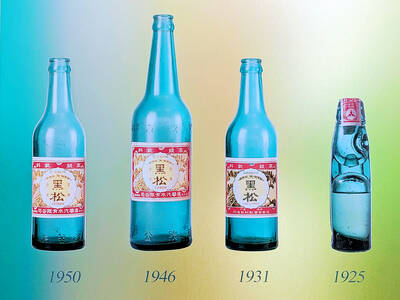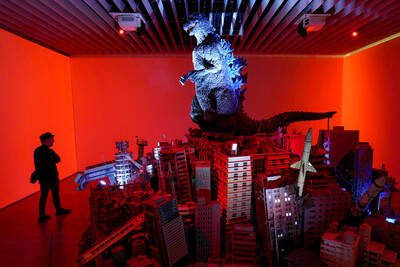While working in Beijing two years ago, Ting Yuan-ju (丁員如) visited a Sichuan hot pot restaurant that had done something different: rather than allowing customers to pick and choose items to boil in a blood-red broth, chefs fried the customer’s chosen ingredients and served the steaming concoction “dry” in a large stainless steel bowl. The unusual hot pot Ting found at Longshunyuan (龍順圓) is famous in China’s capital and after a meal at Red Monster (紅魔王麻辣香鍋), her Taipei rendition of the Beijing original, it’s easy to understand why.
Located five minutes on foot from exit No. 2 of Zhongxiao Dunhua MRT Station (忠孝敦化捷運站), the restaurant’s small interior is framed by non-descript white walls. A half-dozen square tables each seat up to four and three booths in the front are roomy enough for six. Spices from Sichuan used in Red Monster’s dishes are on display in a glass case embedded in one wall.
Our party ordered the set meal (NT$598) for three to four, which came with the dry hot pot, soup, rice and tea. We then chose how spicy we wanted the food on a scale of one to eight, from “not spicy at all” (一點都不辣), to “psycho spicy” (變態辣). We opted for six, or “big spicy” (大辣).
The bitter melon soup, which I usually avoid for its strong flavor, pleasantly surprised with its light broth that had chunks of melon and ginger as well as blanched peanuts and clams. We also ordered some appetizers, including a dish of sweet green chili peppers with black beans that stood out for its unique smoky flavor.
Unlike spicy hot pot — the ingredients of which begin to taste the same after five minutes of boiling — dry hot pot retains the individual flavors of the chicken, beef, prawns, crab, noodles, broccoli, tofu and cabbage, while delicate hints of ginger and cardamom were discernable through the spicy sauce that the mixture was fried in. Vegetarian hot pots are also available.
Ting said that the biggest difference between the Beijing and Taipei restaurants is that hers doesn’t add salt to the food and she uses considerably less oil, which became apparent as we finished off the last morsels (there was only a tiny puddle of crimson oil at the bottom of the bowl).
If you go to Red Monster, its “water from heaven” (甘露水, NT$150), a clear, sweet drink made from corn, sweet potato, lily root and sugar cane, is highly recommended. It will cool the taste buds after a spicy and delicious meal.

Aug. 4 to Aug. 10 When Coca-Cola finally pushed its way into Taiwan’s market in 1968, it allegedly vowed to wipe out its major domestic rival Hey Song within five years. But Hey Song, which began as a manual operation in a family cow shed in 1925, had proven its resilience, surviving numerous setbacks — including the loss of autonomy and nearly all its assets due to the Japanese colonial government’s wartime economic policy. By the 1960s, Hey Song had risen to the top of Taiwan’s beverage industry. This success was driven not only by president Chang Wen-chi’s

Last week, on the heels of the recall election that turned out so badly for Taiwan, came the news that US President Donald Trump had blocked the transit of President William Lai (賴清德) through the US on his way to Latin America. A few days later the international media reported that in June a scheduled visit by Minister of National Defense Wellington Koo (顧立雄) for high level meetings was canceled by the US after China’s President Xi Jinping (習近平) asked Trump to curb US engagement with Taiwan during a June phone call. The cancellation of Lai’s transit was a gaudy

From Godzilla’s fiery atomic breath to post-apocalyptic anime and harrowing depictions of radiation sickness, the influence of the nuclear bombings of Hiroshima and Nagasaki runs deep in Japanese popular culture. In the 80 years since the World War II attacks, stories of destruction and mutation have been fused with fears around natural disasters and, more recently, the Fukushima crisis. Classic manga and anime series Astro Boy is called “Mighty Atom” in Japanese, while city-leveling explosions loom large in other titles such as Akira, Neon Genesis Evangelion and Attack on Titan. “Living through tremendous pain” and overcoming trauma is a recurrent theme in Japan’s

As last month dawned, the Democratic Progressive Party (DPP) was in a good position. The recall campaigns had strong momentum, polling showed many Chinese Nationalist Party (KMT) lawmakers at risk of recall and even the KMT was bracing for losing seats while facing a tsunami of voter fraud investigations. Polling pointed to some of the recalls being a lock for victory. Though in most districts the majority was against recalling their lawmaker, among voters “definitely” planning to vote, there were double-digit margins in favor of recall in at least five districts, with three districts near or above 20 percent in